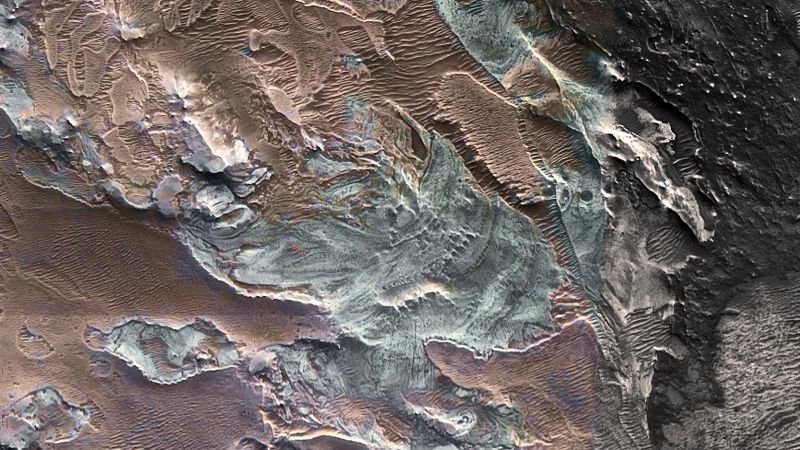() — The remains of a glacier have been found near the Martian equator, suggesting that some form of water might still exist in a region of the red planet where humans might one day reach.
The ice mass is no longer there, but the scientists detected telltale remains among other mineral deposits near the equatorial region of Mars. Deposits there often contain light-colored sulfate salts.
The salt deposits, shown in light blue, are preserved where a glacier likely once existed near the Martian equator.
When the scientists took a closer look, they recognized features of a glacier, including ridges called moraines — debris deposited or pushed by a moving glacier. The research team also detected rift fields, or deep wedge-shaped openings, that form within glaciers.
The findings were shared Wednesday at the 54th Lunar and Planetary Science Conference in The Woodlands, Texas.
“What we have found is not ice, but a salt deposit with the detailed morphological characteristics of a glacier,” the study’s lead author, Dr. Pascal Lee, a senior planetary scientist at the SETI Institute and the Mars Institute, said in a statement. .

This annotated image shows all the details of where the glacier once existed. (NASA MRO HiRISE/CRISM False Color Composite)
“What we think happened here is that salt formed on top of a glacier while retaining the shape of the ice below, down to details like rift fields and moraine bands.”
Researchers believe the glacier was 3.7 miles (6 kilometers) long and 2.5 miles (about 4 kilometers) wide, with an elevation of between 0.8 and 1.1 miles (1.3 to 1, 7 km).
Volcanic activity, a key to the glacier
Scientists have an idea of how the glacier’s footprint came to be, based on evidence of volcanic material in the region. When mixtures of volcanic ash, lava, and volcanic glass called pumice react with water, a hard, crusty layer of salt can form.

A map shows where the remains of the glacier were found near the Martian equator. (Pascal Lee)
“This region of Mars has a history of volcanic activity. And where some of the volcanic material came into contact with the glacier ice, chemical reactions would have taken place at the boundary between the two to form a hardened layer of sulfate salts,” said study co-author Sourabh Shubham, a PhD student at geology at the University of Maryland, College Park, in a statement.
“This is the most likely explanation for the hydrated and hydroxylated sulfates we observed in this light-toned deposit.”
Geologically young surface ice near the equator
The volcanic material likely eroded over time, revealing the salty layer that captured an imprint of the glacier ice and its distinctive features, said study co-author John Schutt, a Mars Institute geologist and a field guide to ice in the Arctic and Antarctica.
Mars has a thin atmosphere, which allows space rocks to regularly collide with the planet’s surface. But the fine, detailed features of the glacier still remain largely intact in the salt deposit, leading researchers to believe that it is relatively “young.”
The study authors said they believe the glacier existed during the Amazonian geologic period of Mars, which began 2.9 billion years ago and continues.

Details of the glacier can be seen in this high-resolution image of the feature. (NASA MRO HiRISE/SETI Institute/Pascal Lee)
“We have known about glacial activity on Mars in many places, even near the equator in the most distant past. And we know about recent glacial activity on Mars, but so far, only at higher latitudes,” Lee said. “A relatively young relict glacier at this location tells us that Mars experienced surface ice in recent times, even near the equator, which is new.”
The researchers don’t know if any ice remains under the reservoir.
“Water ice is currently not stable on the surface of Mars near the equator at these elevations,” Lee said. “So it is not surprising that we are not detecting any water ice on the surface. All the water ice on the glacier may have already sublimated. But there is also the possibility that part of it is still protected at a shallow depth under the sulfate salts.”
Shallow ice packs possible
During the study, the team also observed ancient islands of ice called salt flats in the salt flats of the Bolivian Altiplano in South America. Sheets of salts have protected ancient glacier ice from melting or evaporating, leading researchers to think a similar scenario could have occurred on Mars.
Next, the researchers want to determine if any ice remains from the glacier, and if so, how much is present shallow below the salt deposits. If this particular salt deposit is protecting the ice, there may be other ice packs nearby.
Orbiters circling the planet have shown deposits of ice at the frigid Martian poles, but if water exists in any form in the warmer equatorial low latitudes, it could have implications for our understanding of the Red Planet’s history and potential habitability. and future exploration by humans.
“The desire to get humans to a place where they can extract water ice from the ground has pushed mission planners to consider higher latitude sites,” Lee said. “But these latter environments are often colder and more challenging for humans and robots. If there were equatorial locations where shallow ice could be found, then we would have the best of both environments: warmer conditions for human exploration and still access to ice.”













